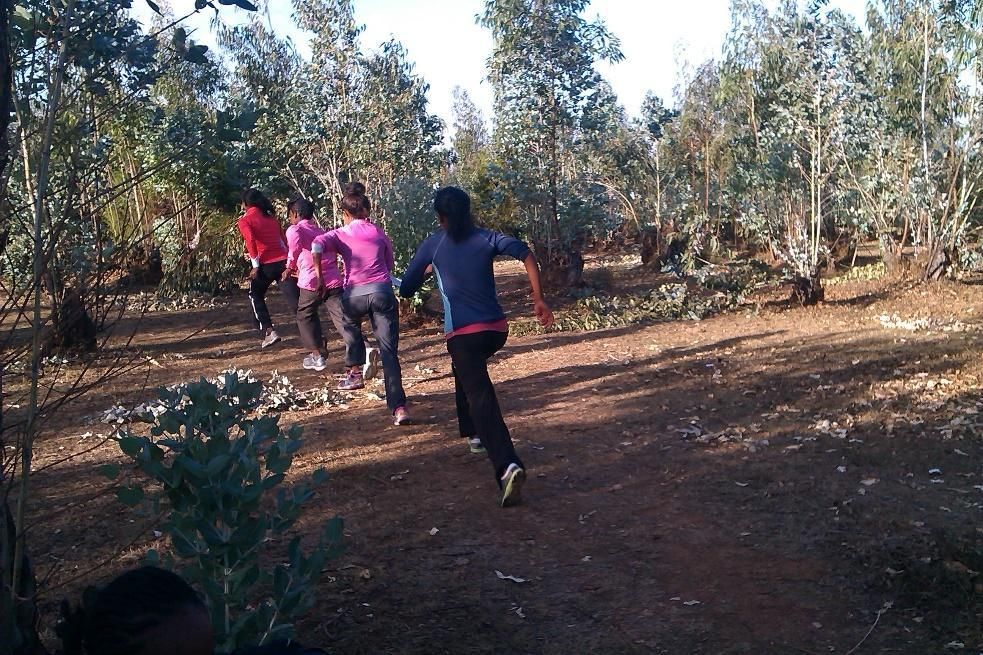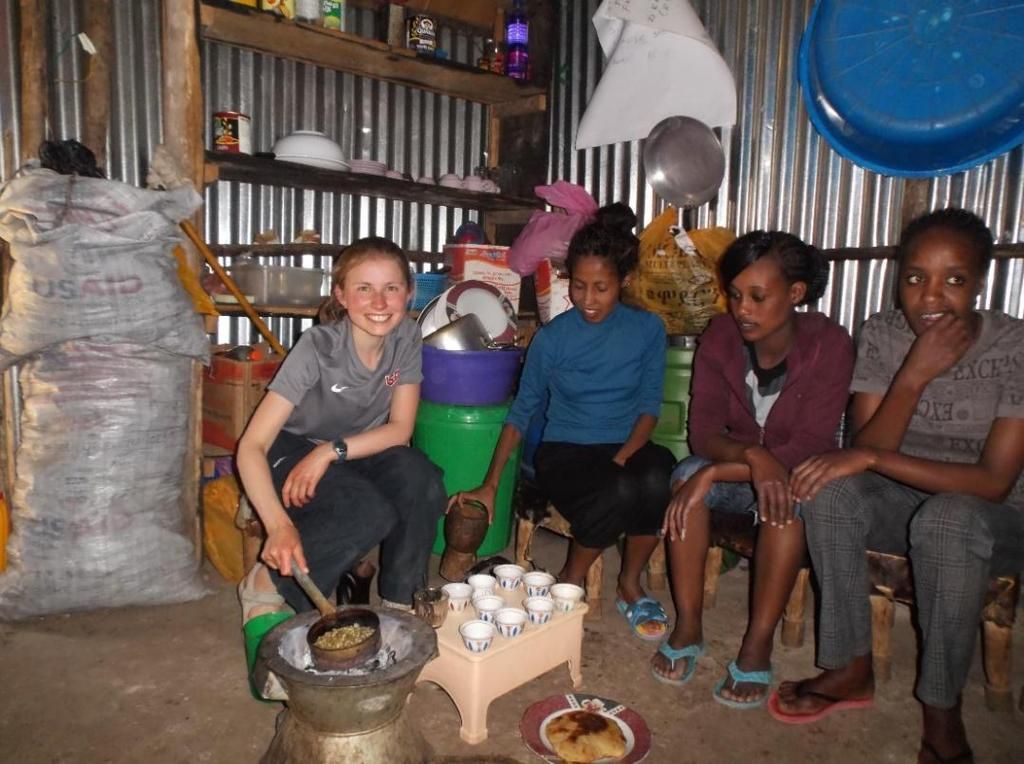Catriona Graves volunteering with the Yaya Girls

Catriona Graves (handicap 5.8) is a GB international mountain runner. After finishing 'A' Levels last summer, she decided to take a year out of education and, after Christmas, headed out to Ethiopia to volunteer with the Yaya Girls. Here, she updates us on how things are in this land that is home to some of the world's finest distance runners.
I have now been at the Yaya Girls for over a month after spending three weeks traveling around Ethiopia. It was great to explore Ethiopia before coming to the Yaya Girls as it gave me the opportunity to find out more about their culture and adapt to the high altitude. Yaya Village is at 2700m which you certainly notice when running.
Everywhere you go it is clear how hard women’s lives are. Everyday you see women and young girls carrying huge piles of firewood, sacks of grains or 30 litre jerry cans of water (I cannot even pick one up let alone carry it for up to 30 minutes) on their backs. Everything is carried using rope or a sheet of cloth which looks very uncomfortable. Fortunately I have not had to try to carry anything myself!
The Yaya Girls is a non-profit organisation that aims to empower women through running and education. We are based at the Yaya Village Hotel, located just outside of Addis Ababa, with the Programme launching in 2012. Five to eight girls from impoverished backgrounds are selected to take part and live at the Yaya Girls every four to five months.
Teaching is provided in five key areas: women’s empowerment, Health and Nutrition, English tutoring, vocational skills and athletics training. Once the girls leave the Programme after their four-month stay they will be strong women role models with the skills to become financially independent.
One of the big factors for me to come to Yaya was for the running. The first few runs were extremely hard due to the altitude but now they are just hard! The area is great for running with lots of trails through the eucalyptus woods and fields. The girls typically run twice a day with an hour run first thing in the morning before breakfast and a short run in the afternoon. Their hard sessions are also before breakfast which took some getting used to.

Running here is different in several ways but one is the multi-directional aspect. At home, we tend to run from A to B, in a foward direction, but running in circles and slalom is what you do here. We weave in and out of the trees changing direction every ten metres. Sometimes I like to switch off when running but I cannot do that here. I have to be constantly alert or run the risk of hitting a tree! On training runs we almost always follow the person in front. This means that you cannot clearly see where you are going so it is your duty to point out any potential hazards, such as the numerous tree stumps or holes that litter the fields. Even so, I have still managed to fall over several times by tripping on a stone or tree root I did not see until it was too late. The girls seem to have no such problems.

The craziest session I have done so far was a 5k tempo run along the main road. There are no pavements here and the road is extremely busy, even at 6am, with lots trucks and lorries. Their easy runs start off really slow but they gradually pick up the pace so that you are exhausted by the end. It is incredible how many people run here. In the morning I regularly see about 50 other runners. They are not just your casual weekend runners either but competitive athletes with personal bests that would easily make the GB team. Running with the girls is a great opportunity to get to know them and try and learn more of their language.
At Yaya village everyone is really friendly and even though I cannot understand most of what they are saying I have still been made to feel welcome. When I was doing hill repetitions last week someone who had already finished their session joined in with me and encouraged me up the hill for the remainder of the repetitions. I was obviously much slower than him so he just treated it as a cool down but it was still amazingly kind. I cannot believe many people in the UK would happily volunteer to run up a hill with you! Yaya Village is a complete contrast to busy Addis Ababa just 10km down the road. Here it is very quiet and peaceful apart from at the weekends when the place is heaving with families and wedding parties.
To get to Addis Ababa you take a rickety, old minibus which is always a bit of an adventure. Just last week I was on the way to my Amharic lesson and the minibus got a puncture. Everyone was very patient and helped to change the tyre. No one seemed the least bit worried and 25 minutes later we were off again. Chigger yellum (no problem) is the favourite phrase of seemingly all Ethiopians. It is funny the looks you get when you say you use the minibuses to get around: astonishment, surprised and impressed to name a few. When I first used them I was overwhelmed and very confused but as long as you know the name of the place where you are going they are manageable. They are also incredibly cheap with the average trip being only 8p ($0.12)
One of my main jobs while I am here is to teach the girls English. Having never taught before this has been difficult but fortunately someone gave us some English textbooks which have been a great help.
 The national dish is injera – a flat, circular bread (about 70cm in diameter) made from teff flour. Teff flour is a highly nutritious grain, especially the brown type that we have at Yaya. It is rich in iron, calcium, vitamin C and protein to name a few. I have to say when I tried my first injera at the beginning of my trip I was not that excited by it. And after a couple of bad experiences (with the injera being rubbery and grainy) I wasn’t sure how I was going to survive three months with only injera for dinner. Fortunately the injera here is quite good and when smothered in the delicious sauces (my favourite being misser a type of lentil stew) it is surprisingly enjoyable.
The national dish is injera – a flat, circular bread (about 70cm in diameter) made from teff flour. Teff flour is a highly nutritious grain, especially the brown type that we have at Yaya. It is rich in iron, calcium, vitamin C and protein to name a few. I have to say when I tried my first injera at the beginning of my trip I was not that excited by it. And after a couple of bad experiences (with the injera being rubbery and grainy) I wasn’t sure how I was going to survive three months with only injera for dinner. Fortunately the injera here is quite good and when smothered in the delicious sauces (my favourite being misser a type of lentil stew) it is surprisingly enjoyable.
I have really enjoyed my last month at the Yaya Girls and cannot wait to see how the girls the girls develop and improve their English over the next few months.
For more on the Yaya Girls and to find out how you can sponsor this project, click here.
